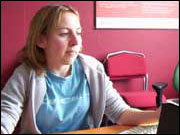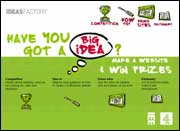Worth Media in Brighton completed a website project
for Channel 4 (4Learning) entitled Ideas Factory TV,
which went live in June 2003. This learning resource
aims to help young people to get into the creative
industries such as new media, film and television.
The help offered by the site ranges from building a
CV to advice on building projects young people might
want to create. There is lots of useful information
about the process involved in creating work for that
kind of medium.
Ideas Factory TV involves a number of regional projects
and this particular one is based in Kent. Kent was
involved in another project two years ago with a
different media company and the aim at that time
was to look at how they could teach pupils of schools
in Kent how to make a website and how to use ICT
in the classroom. This concept was absorbed into
one of the Ideas Factory TV regional projects.
|
|
|

 |
Working to a brief
It's quite a large brief and it's split into two sections. We
got the brief, which was broken down into who the target audience
group were and there were teachers and young people of age group
14 to 25, which is very broad for what we were thinking about and
also it had very clear things that they wanted. They wanted to
have 300 students trained in how to make a website, they wanted
there to be a number of workshops where teachers were taught about
how to ICT in the classroom and they wanted this all singing all
dancing website to support all this, that would teach someone how
to make a website, help them communicate ideas about something
that was scientific or historical or cultural that would look after
the teacher as well and make sure they could use it in the classroom
and have lesson plans and it was huge.
The budget was about £50k,
which for something like that over a year is just not achievable.
They just wanted too much basically
for what they could actually get. Teaching someone how to make
a website, people like Dream Weaver and large companies do that
and you imagine the kind of software and tutorials that are involved
in something like that. To create a good website is actually quite
tricky so they wanted to create a black box solution whereby pupils
could fill in a form and it would automatically do it for them.
We thought what's the point in a student coming along and just
filling in a form and it creating it automatically. They're not
going to learn how to make a website, that's like just how to
fill in a form.
There was basically myself, two projects directors,
a senior developer and a senior designer brainstorming and we
were two days in this
back room chatting away about it all and tearing our hair out,
we can't do this, can't do this, but we want to do this project,
it's a really interesting project. So what we said is we're not
going to fulfil this brief and the brief did have very distinct
things about it and it seemed a bit weird. There was two documents
in one and there was references to things that didn't make sense,
it was all over the place in some ways, and that's when we went
back and said look, we're not going to deliver to this brief,
we're going to do this instead.
The timescale for the brief was for a year, it specified that
and we were happy to keep to that.
Understanding the audience or user
Everything we've done since is made sure that teachers agree
with it, so things like the timescale, who the target audience
group are. We've made sure it's year 9 because that works well
with the teachers, because year 9 have got nothing to do because
they've just finished their SATs. We've made sure it's in June,
so just for six weeks a project and Channel 4 have been ever
so keen now, because they've seen how successful the project
is and how happy the teachers are and partners are. They've kind
of given us the lead really, so we're leading the project and
they're just signing things off as and when.
Fortunately some
clients actually do do audience research before they even go
out to tender with their work, but a lot of them
don't and you sometimes have a conflict between the audience
that are internal to the organisation, what they need, and
then the external audience who actually are coming to the site,
so
for example something like the Department of Health, you might
have internal civil servants versus the general public, and
they've got very different needs and requirements and ways of
actually
understanding things, so there's always a conflict there and
it's about balancing that out quite nicely and thinking about
it, considering it all the time.
Research techniques and methodologies
What we did was we did a kick off consultation with teachers which
happened last summer and that was with all the teachers that were
thinking about being involved, because they hadn't been brought
into this yet by then, so talking to them about what issues they
had, needs, things like that, then we created the project specification,
passed that by them to agree it, so that was consulting with them
again, but on line, and then we met with them recently at the beginning
of January. All the time they're being kept in the loop and we
use that on line project area to keep discussing things and highlighting
things and stuff like that, so we met them in January, they were
all really happy, had a bite to eat, presented the project as it
was going to be, how they would be involved and some kind of initial
designs for the project and then I've just been using the on line
project area recently to just promote - we're going to have a teacher
workshop where they can learn whatever they want to learn - they
get to decide, they get a day.
Design methods
and practical development
One of the things would be the case where when we went to see
the teachers what we had to do was indicate what the site content
would be without actually trying to show too much design, because
we hadn't designed it yet, so what we did was created some content
templates, which is just saying this is what might appear on this
page and this is how you might navigate, and we've got those. It's
like touching on how it might be but without going so far to say
it will be like this because it was such an early stage, so you
need to be quite careful with that, kind of meeting expectations
and about going too much down one pathway and people going oh no,
that's not what we thought you were going to deliver earlier.
Creation and construction
The schedule was done in Microsoft Project and it's just software
based and what you tend to do is split it into the phases of work.
So definition, research and planning, which involves content creation
as well, design planning is also in there, design and build which
is the meat, then the refinement and testing and then the launch.
Then I break it all down into tasks, and then tasks are related
to the people that are working on those tasks days and then costs
associated with that.
Schedule wise, once you know how long people
have got for it, it's being tied in with also how well it fits
with the teachers' plans
as well so we try and make sure it doesn't clash with their Easter
holidays or their own timetables or even the client's. So it's
just making sure it's all feasible within a year span basically
and that's how it's been broken down.
It's just a case of Andy's
just working in Text Editor, he does it all very originally and
that's just the case of building and
designing the site. It's just in templates and then what we
do is create a design template and from that put all the infrastructure
in place and then actually just drop the content in.
Presenting and gathering feedback
We'll be presenting the site to show it to them and check they
can use it ok, but use the workshop, so we're opening it out to
them. It could be used to learn more about ICT or you could use
it like this, but you tell us and we'll sort it out for you. So
again, keeping them in the loop. Then what we'll start to do is
get a small group of students from each of the schools to just
look at the site and check it's working for them as well, and a
lot of that will be done on line, through telephone conversations
and using the on line project area.
|

